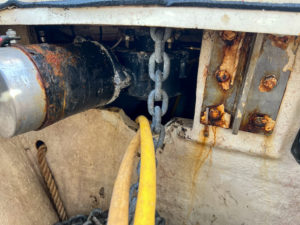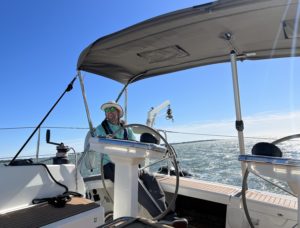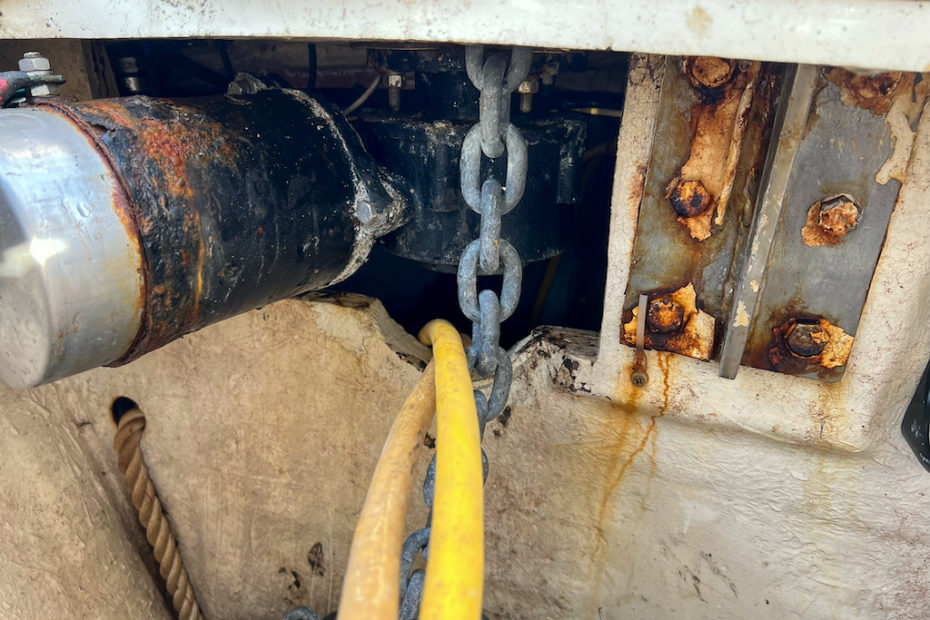(Reading time: 3min 15sec)
“I really think we need to do one windlass at a time,” I said, frustrated again that Charlie clearly knows more than I do, but I have to voice my opinion. The windlass project has been niggling in my mind for weeks as it poses a blocker to us getting off the dock long term. Whenever we’ve gone up to the boat, I’ve wanted to start the project, but Charlie has a different urgency.
After months of having this project on our list, we have yet to begin. I brought it up at dinner the other night because we are quickly approaching our “move-in” date, and I have no line of sight for fixing our windlass motors (and thus, enabling us to anchor out). WTF are we doing?!
“The project makes more sense to do both windlasses at the same time because there is more than just the motor,” Charlie insists. He’s frustrated. I’m frustrated. How are we on such different pages when we have the same goals?

A Tense Discussion Evolves
As we debated the project, I was emphatic that I wanted to tackle the project a specific way: do one windlass motor replacement to completion and then do the 2nd windlass motor replacement (this came up on the survey). My logic: we’d learn lessons in the first pass of the replacement work and be able to complete the 2nd replacement much more quickly.
Charlie strongly disagreed. Our discussion became more animated (i.e., tense, sometimes defensive, my insecurities bubbled up, etc.) as he described his view of the project, which includes digging through the wiring and servicing the windlass itself.
The more we debated the project, the discussion became less about the windlass work and more about how we work together. This is the first of many projects we will DIY, and we already disagree over it. How will we tackle more significant efforts like standing rigging or an electrical overhaul?
A Step Back in Time
Charlie and I have spent most of our 20+ year relationship partnering on initiatives. It all started when we decided to buy our first house together (2005). We didn’t have the guise of marriage to make assumptions about how our co-ownership of the property would work. Additionally, we don’t automatically defer to traditional gender roles. In other words, we assumed a lot and had tense interactions over basic housework and home maintenance.
Thus, we spent much time in the early years working out who would do what and how to eliminate expectations to avoid unnecessary conflict. That included (not limited to) discussing taking out the trash, doing the dishes, and mowing the lawn. By agreeing to explicit roles and responsibilities, we eliminated tension by removing expectations. After all, expectations are pre-meditated resentments.
Sailboat Roles & Responsibilities
The most beautiful thing happened as the debate about the windlass project turned into a discussion about how we’d approach sailboat projects: what if we segregated our responsibilities into areas we’re naturally interested in?
For example, I (Pinky) am interested in weather and navigation. Charlie has said for a while that he’s not interested in those areas and would love me to run point on them. He has expressed interest in the electrical system and rigging, two systems that currently overwhelm me. Once we uncovered the tip of this iceberg, we decided to expose the whole thing. Let’s go through the boat systems and choose who would lead that system. Here’s where we landed:
Pinky
- Weather & Navigation: all things weather, charts, route planning, etc.
- Electronics: chart plotters, computers, etc.
- Software: boat management, weather, etc.
- Communications: website, radio, social interactions
- Hull & Deck: graphics, fiberglass, gel coat, etc.
- Chemicals: paint, epoxy, cleaners, etc.
- Medical: medkit, etc.
Charlie
- Mechanical: diesel, outboard, steering, anchoring, etc.
- Electrical: anything that plugs into a device
- Plumbing: anything with a pump
- Networking: internet connectivity, wiring in the boat, etc.
- Safety: life raft, flares, training, etc.
- Rigging: standing, running, etc.
Eliminating that conflict makes this whole thing a lot more fun, and that’s a key metric to our journey. When it’s not fun, what are we even doing here?
-Pinky & Charlie

Don’t get us wrong. We will both need to have knowledge of all these systems, which is absolutely the goal. We plan to teach each other along the way, building team knowledge as part of our partnership in owning and running the sailboat (our new home).
The nuance is that we can focus on areas that genuinely interest us. The bonus: we each have clear points on which to defer.
I defer to Charlie’s knowledge of windlass maintenance because I trust that he knows more than I do, and he’s responsible for knowing the right way to do it. We have explicitly agreed that it’s okay for me to lack that knowledge (until he teaches me), which eliminates my insecurity. As it turns out, that insecurity is the source of tension and conflict. Eliminating that conflict makes this whole thing a lot more fun, and that’s a key metric to our journey. When it’s not fun, what are we even doing here?
Discover more from SV Loka
Subscribe to get the latest posts sent to your email.

Great perspective on how to approach responsibilities on the boat.
Pingback: DIY + Vendor Education: Our Experience – SV Loka